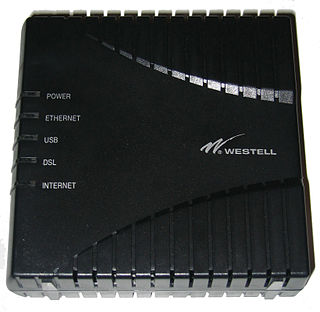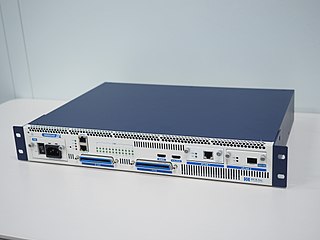 W
WA DSL loop extender is a device that a telephone company can place between subscriber premises equipment and central office interfaces to extend the distance and increase the channel capacity of digital subscriber line (DSL) connections. ADSL repeaters are deployed by rural telephone companies trying to provide rural Internet service to farms and small towns where it is impractical to place the DSLAM closer to the subscriber. Typical distance improvements with a loop extender are shown in the diagram below, with rate in megabits per second and distance in thousands of feet.
 W
WAsymmetric digital subscriber line (ADSL) is a type of digital subscriber line (DSL) technology, a data communications technology that enables faster data transmission over copper telephone lines than a conventional voiceband modem can provide. ADSL differs from the less common symmetric digital subscriber line (SDSL). In ADSL, bandwidth and bit rate are said to be asymmetric, meaning greater toward the customer premises (downstream) than the reverse (upstream). Providers usually market ADSL as an Internet access service primarily for downloading content from the Internet, but not for serving content accessed by others.
 W
WA broadband remote access server routes traffic to and from broadband remote access devices such as digital subscriber line access multiplexers (DSLAM) on an Internet service provider's (ISP) network. BRAS can also be referred to as a Broadband Network Gateway (BNG).
 W
WJohn Mathew Cioffi is an American electrical engineer, educator and inventor who has made contributions in telecommunication system theory, specifically in coding theory and information theory. Best known as "the father of DSL," Cioffi's pioneering research was instrumental in making digital subscriber line (DSL) technology practical and has led to over 400 publications and more than 100 pending or issued patents, many of which are licensed.
 W
WA digital subscriber line access multiplexer is a network device, often located in telephone exchanges, that connects multiple customer digital subscriber line (DSL) interfaces to a high-speed digital communications channel using multiplexing techniques.
 W
WA DSL filter is an analog low-pass filter installed between analog devices and a plain old telephone service (POTS) line. The DSL filter prevents interference between such devices and a digital subscriber line (DSL) service connected to the same line. Without DSL filters, signals or echoes from analog devices at the top of their frequency range can reduce performance and create connection problems with DSL service, while those from the DSL service at the bottom of its range can cause line noise and other problems for analog devices.
 W
WA digital subscriber line (DSL) modem is a device used to connect a computer or router to a telephone line which provides the digital subscriber line service for connection to the Internet, which is often called DSL broadband.
 W
WITU G.992.3 is an ITU standard, also referred to as ADSL2 or G.dmt.bis. It optionally extends the capability of basic ADSL in data rates to 12 Mbit/s downstream and, depending on Annex version, up to 3.5 Mbit/s upstream. ADSL2 uses the same bandwidth as ADSL but achieves higher throughput via improved modulation techniques. Actual speeds may decrease depending on line quality; usually the most significant factor in line quality is the distance from the DSLAM to the customer's equipment.
 W
WAnnex J is a specification in ITU-T recommendations G.992.3 and G.992.5 for all digital mode ADSL with improved spectral compatibility with ADSL over ISDN, which means that it is a type of naked DSL which will not disturb existing Annex B ADSL services in the same cable binder.
 W
WAnnex M is an optional specification in ITU-T recommendations G.992.3 (ADSL2) and G.992.5 (ADSL2+), also referred to as ADSL2 M and ADSL2+ M. This specification extends the capability of commonly deployed Annex A by more than doubling the number of upstream bits. The data rates can be as high as 12 or 24 Mbit/s downstream and 3 Mbit/s upstream depending on the distance from the DSLAM to the customer's premises.
 W
WG.fast is a digital subscriber line (DSL) protocol standard for local loops shorter than 500 m, with performance targets between 100 Mbit/s and 1 Gbit/s, depending on loop length. High speeds are only achieved over very short loops. Although G.fast was initially designed for loops shorter than 250 meters, Sckipio in early 2015 demonstrated G.fast delivering speeds over 100 Mbit/s nearly 500 meters and the EU announced a research project.
 W
WThe Nokia M1122 is a 4-port ADSL router that is known to have been sold in Europe and New Zealand in 2000-2002. In addition to its main task, the M1122 is capable of acting as a 10 Mbit/s Ethernet hub in a local area network.
 W
WSocket is a Missouri-based telecommunications provider, with its headquarters in Columbia, Missouri. Socket is a privately held company and offers local and long distance phone service, DSL and fiber-optic internet, and data technology to residents and businesses across Missouri.